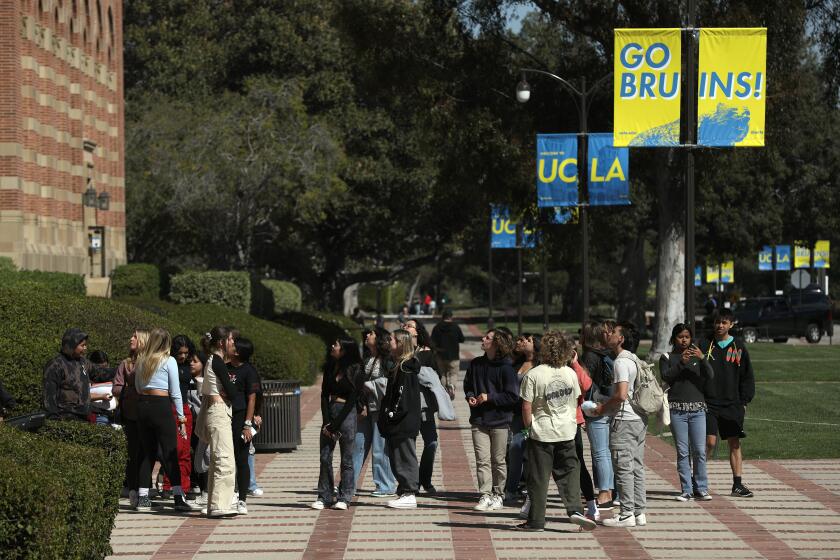State Prison System’s ‘Heaven on Earth’ : Although Overcrowded, Men’s Colony Has Less-Violent Environment
- Share via
SAN LUIS OBISPO — “I call this heaven on earth,” the young guard said.
She was talking about the California Men’s Colony, the heavy-medium security state prison just west of San Luis Obispo where 4,200 convicts--many of them violent offenders--are jammed into space designed for 2,400.
If this seems like heaven, it is probably because Correctional Sgt. Julie Caraway spent more than six years in hell.
Caraway worked from 1978 until 1984 at San Quentin prison.
“It was nothing to come to work at 7 a.m.,” she recalled of San Quentin, “and have an incident at 7:02--a match bomb or feces thrown on staff--and then go out to the yard and have a sticking and a (warning) shot fired.
‘Controlled Every Movement’
“At San Quentin,” she said, “I controlled every movement they (the prisoners) made. The only thing they could do on their own was breathe.”
When she arrived at the Men’s Colony in September, 1984, she was shocked to find inmates leaving their cells in the morning, going unescorted to work or school in other parts of the prison and returning, on their own, to their cells at night.
“When I first got here,” Caraway said, “I wanted to go back (to San Quentin). There was no way I could see this place functioning.”
But the prison does function, and Caraway was surprised to meet transferred inmates living on the mainline of the Men’s Colony who had been kept in the highest security lockup units at San Quentin.
“They come in here, and they’re different people,” she said.
Caraway believes that up to 40% of the 2,500 inmates at San Quentin could function in a setting such as the Men’s Colony.
Ironically, she says San Quentin could not function without those same convicts, who are needed to help operate the prison.
Corrections officials agree that the Men’s Colony is a far safer place for inmates and staff members than San Quentin despite severe overcrowding here.
State Department of Corrections figures show, for example, that San Quentin recorded a rate of 14.22 assaults per 100 inmates in 1984 while operating at 107% of inmate population design capacity. The Men’s Colony recorded an assault rate of 1.77 per 100 inmates during the same year while the prison operated at 137% of design capacity. The difference in the assault rates is probably even greater than these figures show because data for the Men’s Colony includes assaults by convicts kept at the state mental hospital in nearby Atascadero.
Although officers at San Quentin frequently are targets of inmates wielding spears, there have been no spearing incidents at the Men’s Colony this year, administrators said.
Inmates at violent prisons such as San Quentin, Folsom and Tracy have been locked in their cells for extended periods on countless occasions because of disturbances over the last decade. The Men’s Colony has been entirely locked down once in the last 10 years and partially locked down three times, according to administrators.
Prison officials give a number of reasons that the Men’s Colony has remained relatively safe--as prisons go--despite overcrowding that has now pushed the facility to 175% of capacity. (Hinged beds, which are folded up during the day, have been installed in most of the cells at the Men’s Colony in order to house two inmates per cell.)
Modular Design
First of all, Deputy Warden Ted Gutierrez explained, the Men’s Colony, which was built in 1961, is designed in quads that essentially function as four separate, more manageable prisons than the huge old institutions such as San Quentin.
In addition, the prison offers more opportunities for work, education and training than many penitentiaries.
Officials also say that the Men’s Colony is considered neutral territory by prison gangs.
Most of the Men’s Colony prisoners are not considered as hardened or as volatile as many of the convicts at San Quentin or Folsom.
Possibly one of the most important factors in dealing with violence at the Men’s Colony is that the inmates have something to lose. They know they can be sent to places that are far worse. And in some cases that could be fatal.
James Phillips, 27, is now an inmate at the Men’s Colony after two years at Tracy.
“It (the Men’s Colony) is a better place,” he said. “And a lot of these guys are ex-gang members so they know if they go back . . . it’s their lives.”










